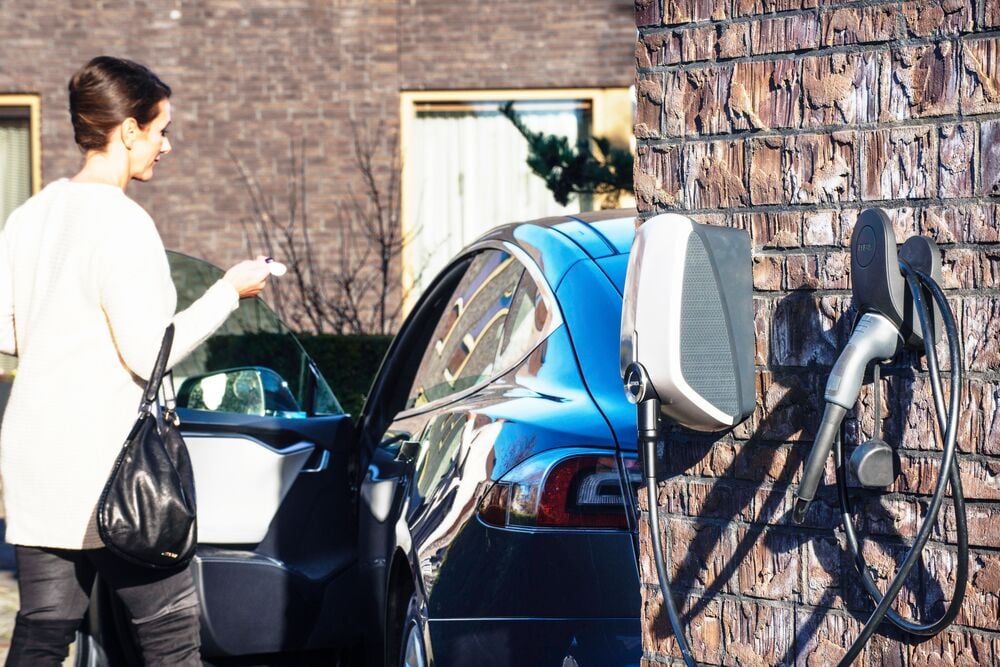
Electric mobility is undoubtedly on the rise. Today, there are over 10 million electric vehicles registered on the roads and according to the International Energy Agency, that number is expected to rise to 145 million by the end of the decade.
But perhaps what’s most telling is how consumers feel. Mindsets of millions have also shifted toward electric mobility, with over 45 percent of consumers considering buying an EV. This is far from surprising. Driving an electric vehicle is not only more sustainable, but less polluting and cheaper to run than any vehicle with an internal combustion engine (ICE). What’s more, depending on how you drive, it can potentially offer a lot more convenience too.
While it is a fact that charging an EV takes longer than filling up with fuel, the majority of the time you don’t have to go out of your way to fill up. Rather than driving to a petrol station, you can charge wherever you park. And one of the best places to do this is at home.
As EV become more commonplace, the bulk of the charging will take place at home. However, whilst charging at home is convenient, the concept is also very new and different. In this post, we’re going to answer some frequently asked questions about charging at home, tell you what you’ll need to get started, and dive into some factors which influence costs and convenience.

Charging at home is more convenient
We’ve all been there: You're low on fuel and you need to fill up. But you’ve got to get home in time for dinner. Maybe there’ll be time tomorrow morning before that big meeting. But maybe not? What do you do?
As you can charge an electric car at home, you don’t have to go out of your way to charge up on your journey. No more detours to the petrol station; you can literally charge your vehicle as you eat, play or sleep. Want to know how long it takes to charge at home? Check out this page for a more extensive overview of EV charging at home.
This convenience, to leave the house with a full battery, is not only time-efficient, but it also helps to reduce one of the main reservations many potential EV drivers have: range anxiety—the fear of running out of charge and not being able to find a charging station. However, in most daily driving situations, such as going to the office, dropping the kids off at school, or doing the weekly shop, you won’t come close to reaching the median range of an EV (which currently sits around 250 miles).

Electric car home charging stations: what are the possibilities?
There are three different Levels of EV charging that you can use to power your vehicle—Level 1, Level 2, and Level 3. The higher the charging Level, the higher the power output and the faster it will charge your car.
In this section, we will go over the three different types of EV charging stations available on the market and which is best for your home.
Level 1 charging
Level 1 charging involves plugging your electric car into a traditional household socket. As the charger can only draw a small amount of power, it is the slowest way to charge an electric vehicle. However, it is also the most accessible and affordable way to charge an EV as you don’t need any additional infrastructure at your home and the cable often comes with the car.
As the maximum output of a Level 1 charger is 2.3kW, one hour of charge will provide approximately 4-5 miles of range. To demonstrate this, a small passenger car, such as the Nissan Leaf, with a battery capacity of 40 kilowatt-hours (kWh), would take approximately 20 hours to fully charge at this Level.
Depending on the number of miles you drive on average, Level 1 charging might be more than enough. If you drive 50 miles a day, this means it will take you between 10 to 12.5 hours to fully charge your vehicle. However, because Level 1 is limited in its charging capabilities and not always as safe as you would like it to be, the majority of EV owners opt for a Level 2 charging station instead.
Level 2 charging
Level 2 (also referred to as residential or AC) charging, is the next step up in EV charging: it’s faster, smarter, safer and more cost-efficient than Level 1 charging. They can be found at homes and blocks of flats, as well as public spaces, commercial car parks, or at the office. Unlike Level 1 chargers, Level 2 chargers are separate stations that offer relatively fast charging speeds. However, this depends entirely on the power output.
At a minimum, Level 2 charging stations have the ability to deliver between 3.7 kW and 22 kW of power to an electric vehicle. At 22 kW, a Level 2 charging station can fully charge a Tesla Model S with a 75 kW battery in approximately 3 hours and 40 minutes.
Whilst they need to be installed by a professional at your home, a Level 2 charging station is ideal as they usually don’t require costly grid upgrades—simply connecting to your home’s electricity supply via either 1-phase or 3-phase connectors.
Level 3 charging
Level 3 or DC fast charging, is the fastest way to charge an electric vehicle. At speeds from 50 kWh up to 250 kWh, a Level 3 charging station can charge an EV in the time it takes to have a coffee. However, due to the high-output power, this kind of charging station requires a lot of space and costs roughly 50 times more than what a Level 2 charging station might. As such, you don’t see Level 3 chargers in residential settings.
Instead, the major benefits of Level 3 charging lend themselves to being used in public and commercial settings. For more information about Level 3 or DC fast charging, take a look at this blog: What is Level 3 charging?
What is the best electric car home charger?
Residential charging stations are usually Level 2 charging stations. Although many EV drivers start with Level 1 charging, they end up choosing to invest in a Level 2 charging station as it offers more functionality, safety, convenience and speed than its Level 1 counterparts.

How fast is a Level 2 charger?
Level 2 charging stations deliver between 3.7 and 22 kW of power output. With a Level 2 charging station at a maximum power output, one hour of charge will provide approximately 75 miles of range for an average EV.
However, as with all hardware, there are many different factors which affect the charging speeds. Firstly, the speed of residential charging stations varies depending on the type of charging point: 1-Phase or 3-Phase, and whether they deliver 16 A or 32 A, the residential locations power output, and the type of EV.
For an example of the different charging speeds for a Level 2 charging station at home, here is an overview of how long it will take to fully charge a Tesla Model 3.
| 1-Phase, 16A | 3.7 kW | 14h45m |
| 1-Phase, 32A | 7.4 kW | 7h20m |
| 3-Phase, 16A | 11 kW | 5h00m |
| 3-Phase, 32A | 22 kW | 3h45m |
As some residential homes may not be wired to deliver 22 kW of power, charging speeds will depend on how much power your home can take from the grid.
/Home/0232EV-Box-web.jpg?width=2560&name=0232EV-Box-web.jpg)
What does it cost to charge an electric car?
Perhaps one of the most important aspects of home charging is price. Did you know that charging your EV at home is almost always cheaper than filling up with petrol or diesel? The price, however, depends on your vehicle's capacity, the fees you pay to your energy supplier, and when you charge.
In the UK, the average price of energy is approximately £0.17 per kWh. What does this mean in practice? Well, the average electric car can travel around 4 miles per kWh. So, based on the UK average annual mileage of 12,000, you would need 3,000 kWh to charge your electric car over the course of the year. At £0.17 per kWh, charging your vehicle at home would cost approximately £510 a year, which equates to £42.50 a month.

Should you charge your EV every night?
In most cases, charging your electric car every night isn’t necessary and isn’t best practice as it can affect the lifespan of your battery. While it is a personal preference—you may feel better leaving home with the knowledge you have a full battery—there is research that shows that it can shorten the lifespan of the car's battery.
According to the researchers at the University of Michigan, always charging your vehicle to 100 percent state of charge (SoC) can cause stress. Instead consumers should minimise the amount of time a battery spends at either 0 or 100 percent charge. The reason being that extremely high or SoC puts stress on the battery and can shorten their life.
Therefore, one key recommendation is to keep an EVs SoC between 20 and 80 percent charge, and only charge when necessary.
/Home/0110EV-Box_web.jpg?width=1920&name=0110EV-Box_web.jpg)
How to reduce costs for EV home charging
To reduce costs for charging at home, it is important to consider multiple factors, including the features your EV charging station has, when you charge, and whether you draw energy from the grid or use solar panels.
Here are five tips to keep the cost of charging your EV at home down:
- Make sure the chagrin station allows for scheduled charging. With scheduled charging, you can charge your EV during off-peak hours when the cost is lowest.
- Keep an eye on your charging session insight: by looking into your charging habits, you can gain an understanding of both power usage and costs to model your charging schedule accordingly.
- Consider using a green energy supply and profit from energy creation. By connecting your charging station to renewable energy supply, like solar panels, you can produce your own electricity and reduce your reliance on electricity from the grid.
- Charging more than one EV? Then you should look for a charging station with load balancing. By distributing power between multiple EVs when charging, load balancing optimises the power output to ensure charging is smart, safe and evenly distributed.
- Ask your employer to reimburse you for charging costs. If you are an employee, there is a chance your employer might want to contribute to your monthly transport costs.
Before investing in a home charging station, it is important to look into which of these features suits your needs and whether the chagrin station you choose provides them.
Want to learn more about charging at home? Check out this page for more information about home charging and all the frequently asked questions.